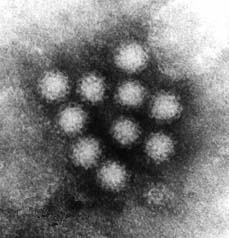Perhaps because they were easier to control and kill,
zombies never acquired the cachet of their vampiric cousins. This phenomenon extended to science: zombic research was considered a less glamorous field and consistently lagged behind vampiric research in funding. Since development of the vaccine in 1911, the zombic threat has been greatly reduced. However, this should not make us complacent: most experts believe that in today's world, a zombism outbreak is far more likely than vampirism.
The Virus
The
human zombism virus (HZV) comes from the same Mononegavirales order as the human vampirism virus, and bears the same distinct bullet shape—although it's only twice the size of rabies, while HVV is triple.
 |
Zombic plague spreaders:
the brown rat & hard tick |
The virus is propagated mainly through ticks of the family Ixodidae, which have hard shells instead of soft. The prevalence of these ticks in tropical climes is the main reason for the large number of outbreaks in those regions. The nature of the spread of zombic plagues generally depends on the place of origin: most urban plagues were spread by aggressive rats that had been bitten by an infected tick; in the country, the tick would bite humans directly, or pass the virus through mice, raccoons and other mammals.
As is the case with vampirism, humans infected with HZV mainly pass it from their saliva into the bloodstream of another through bite wounds.
Depending on soil conditions and UV exposure, the zombism virus can remain active in zombic excrement and carrion for anywhere between 15 days and all the way up to three months—compared with only 5 days to one month for the vampirism virus. Needless to say, this poses a real danger to water supplies. The best ways to treat water potentially tainted with the virus include the use of chlorine, ozone and in some cases bromine or iodination.
Regarding the virus' evolutionary lineage, structural and genetic similarities between HVV and HZV suggest that both vampires and zombies share a common ancestor, which was likely more zombie-like than vampiric.
Stages of the Disease
The stages of zombic transformation are the same as those that occur in vampires, with two major differences: for zombism, the onset of symptoms and transformation occur much faster, and has no relation to the cycles of day and night.
 |
The zombism virus,
magnified 6500 times |
If the victim is bitten by a zombie, there's also the added risk of the wound becoming septic, since zombic mouths are ridden with dangerous bacteria and other microbes. In most cases, it can only become fatal if the victim is vaccinated without also being treated with antibiotics, as the virus can prevent the onset of clinical death.
Stage One: Infection.
Symptoms of zombism appear quickly: within one or two hours, the victim will develop a headache, fever, chills and other flu-like symptoms, along with extreme thirst, severe itching and increased heart rate and metabolism. This stage lasts about half as long as its vampiric counterpart—mostly between three and six hours, during which the vaccine is about 99 percent effective. Unlike vampire bites, zombie bites clot pretty quickly; however, the higher bacteria count can cause even worse pain and inflammation, with copious amounts of pus.
 |
A bite victim under quarantine
in Panama; 1905 |
Stage Two: Coma.
Zombic comas are considerably more brief than vampiric ones, lasting only four to six hours as opposed to a day. Unfortunately, even though the fever is shorter, it also burns higher, which ends up causing brain damage. Only the very young and very old do not survive zombic comas, although zombies have been found as young as five and as old as 90. As with vampirism, the vaccine is roughly 50 percent effective when administered during the first half of this stage: the longer the coma has passed, the less effective the vaccine. Cardiac arrest occurs within two to three hours as blood flow, breathing, metabolism and body temperature plummet to almost nothing.
Stage Three: Transformation.
Zombies awaken from their comas in a catatonic state. They are unresponsive to most stimuli as they shuffle about, trying to locate human flesh. Unlike vampires, there is no acclimation period: zombies will begin hunting immediately upon transformation.
The Vaccine
Perhaps because zombies weren't as much of a threat to our ancestors, natural immunity against the zombism virus isn't nearly as common as with vampirism—only one in every 450 people as opposed to one in every 150—so immune blood was a lot harder to come by for treatment purposes. Fortunately, there was a silver lining.
 |
FVZA scientists at a vaccine
production facility; 1944 |
Compared to the human vampirism virus, the creation of a zombism vaccine was a much simpler process. In the year 1911, the French had accomplished this all-important task by using the same method as many other vaccines: chemically-killed virus suspended in a solution that's injected into the patient's muscle tissue. It was dubbed the "Pasteur Project," in honor of Louis Pasteur's groundbreaking medical research in the years before his death in 1895.
As for post-exposure infections, a transfusion of immune or inoculated blood was required to provide antibodies along with the vaccine, until the creation of the human zombism immune globulin during the 1940s Zozobra Project.
Sadly, as with their vampiric counterparts, every available dose of the zombism vaccine and globulin is currently stored at the CDC headquarters in Atlanta, Georgia—and in equally-limited numbers (approximately 250,000).
Continue to Zombic Biology
© 2001-2021 Dango Productions, Inc.







